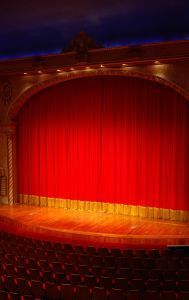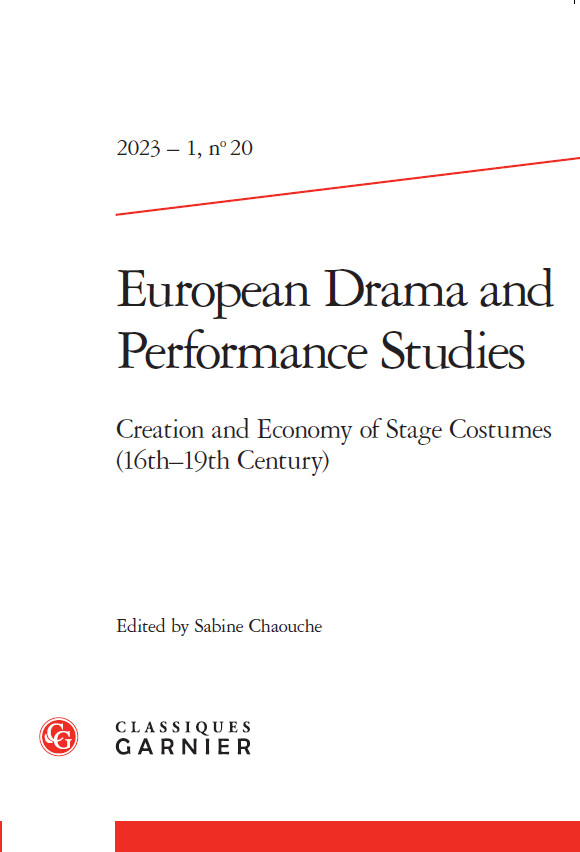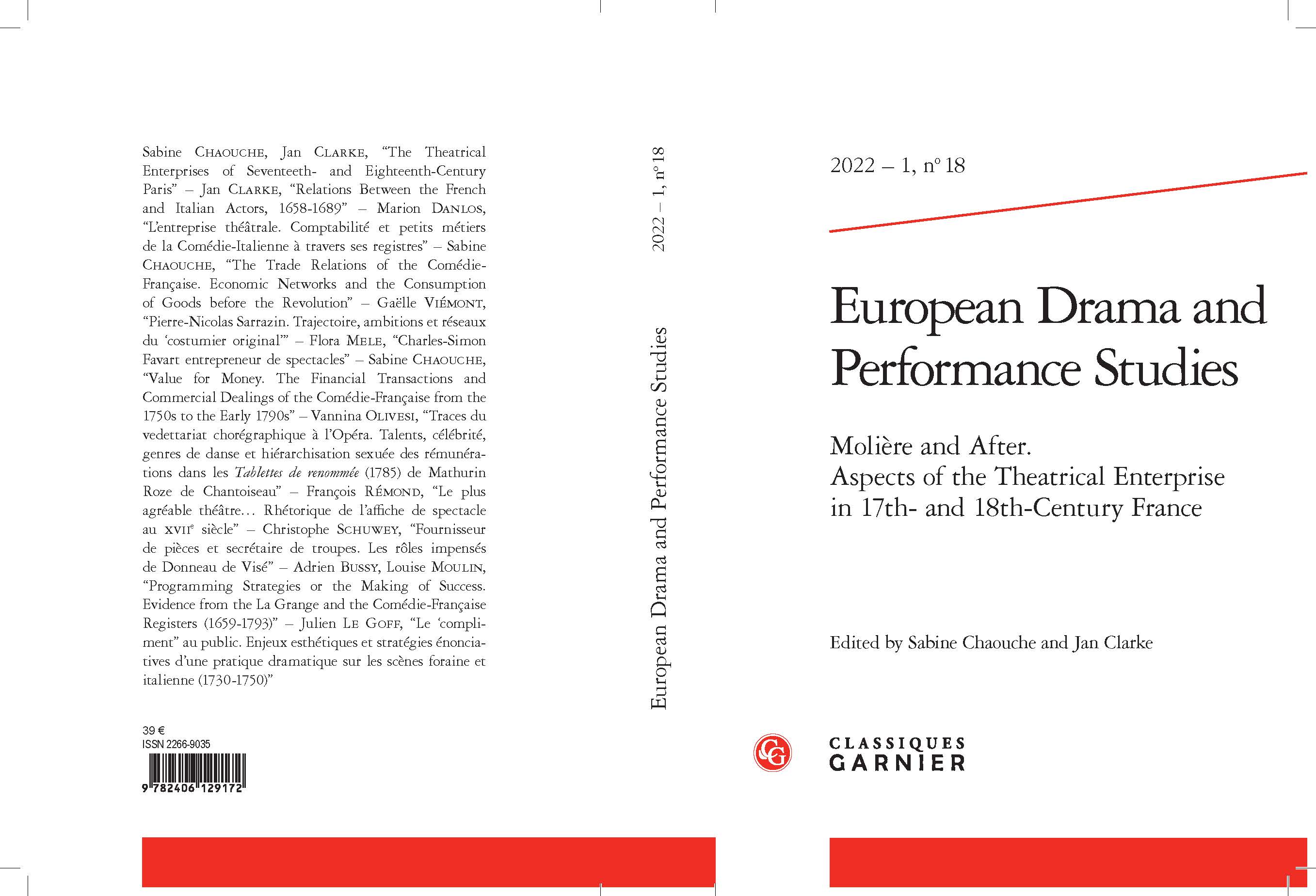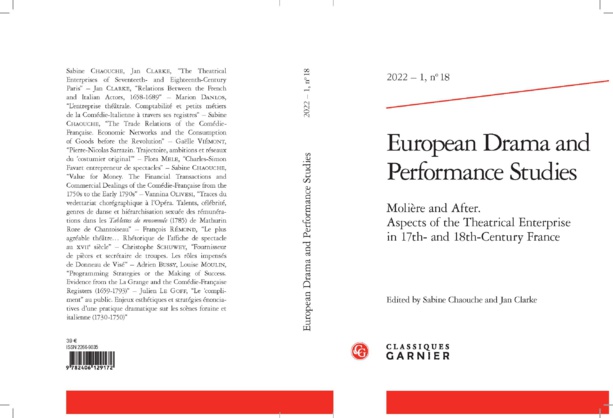https://classiques-garnier.com/european-drama-and-performance-studies-2022-1-n-18-moliere-and-after-aspects-of-the-theatrical-enterprise-in-17th-and-18th-century-france-en.html
In 2022, the 400th anniversary of Molière’s birth was celebrated by means of conferences, exhibitions and publications worldwide. The enthusiasm with which this event was greeted demonstrates the dramatist’s continued significance for multiple audiences – in theatres, universities, and among the general public.
The present volume seeks to contribute to this commemoration of the man who (after Shakespeare) was undoubtedly one of the greatest actor-dramatists and all round ‘men of the theatre’ the world has ever known through an examination of Molière’s legacy with regard to the specific field of entrepreneurship. For, while Molière’s outstanding talents as a playwright, actor and stage-director have been praised and analysed by generations of scholars in the fields of literary and performance studies, his work as a company director and entrepreneur, and the economic context in which he and his troupe operated, has all too often been overlooked.
The focus of the present volume is fundamentally Parisian, which is the case for the majority of studies of the seventeenth-century French theatre scene and, to a lesser extent, that of the eighteenth century, although Lauren R. Clay’s Stagestruck (2013) is a notable exception. This is because, as previously noted, our field of research is to a great extent determined by the resources available to us.Molière’s troupe segued via the Guénégaud into the Comédie-Française. The happy result is that three account books relating to the activity of Molière’s company (known as the the two ‘La Thorillière’ and the ‘Hubert’ account books) plus the personal summary of the official registres made by the actor La Grange are preserved in the Bibliothèque-Musée of that institution, together with all the Guénégaud account books and the majority of those for the Comédie-Française, from 1680 to the present day. On the other hand, the majority of the Molière account books, plus all those for the Hôtel de Bourgogne, the Marais and the Italians prior to 1716 are lost, which makes any investigation into the activity of these companies far more problematic. In fact, the various account books provide the source material for a significant number of the articles in the volume, notably Adrien Bussy and Louise Moulin on ‘Programming Strategies’ and Marion Danlos on the petits métiers of the Comédie-Italienne after 1716 as revealed by its account books. The Bibliothèque-Musée of the Comédie-Française also holds a wealth of other documents, including the minutes of the troupe’s fortnightly administrative meetings and other items relating to the accounts, and these have been used extensively by Jan Clarke in her work on the rivalry between the French and the Italians, and by Sabine Chaouche in her linked studies of the troupe’s relations with its suppliers and the effect of its location on the neighbourhood.
The available audience for theatre in this period was ludicrously small by modern standards, which rendered competition between the companies all the more intense. It is little wonder, then, that they should have put considerable energy into advertising themselves and their activities, as is demonstrated in several of the articles here. Thus, Christophe Schuwey discusses the career of that indefatigable promoter of himself and his friends, Jean Donneau de Visé; François Rémond examines the use of theatre posters; and Julien Le Goff considers the ‘compliment’ that the actors addressed to the audience at the end of each performance. A considerable part of the theatre’s appeal was derived from spectacle, to which costumes, music and dance contributed not a little. But, like so many others operating in this field, the costumier was also an entrepreneur, with his own business networks and deploying his own strategies, as Gaelle Viémont demonstrates. While Vannina Olivesi takes on the all-too modern topic of the gender pay gap as it applied to dancers at the Paris Opéra. Finally, Flora Mèle discusses the career of one of the most celebrated of eighteenth-century entrepreneurs, who can truly be said to inhabit the Molière legacy, Charles-Simon Favart.
In this way, we demonstrate that early modern theatre already possessed many of those characteristics associated with the ‘theatre industry’ as it would later develop and that these seventeenth- and eighteenth-century practitioners were worth successors to Molière as they struggled to ensure their survival, while simultaneously making a major contribution not only to the cultural life of the capital but also to its economy.
In 2022, the 400th anniversary of Molière’s birth was celebrated by means of conferences, exhibitions and publications worldwide. The enthusiasm with which this event was greeted demonstrates the dramatist’s continued significance for multiple audiences – in theatres, universities, and among the general public.
The present volume seeks to contribute to this commemoration of the man who (after Shakespeare) was undoubtedly one of the greatest actor-dramatists and all round ‘men of the theatre’ the world has ever known through an examination of Molière’s legacy with regard to the specific field of entrepreneurship. For, while Molière’s outstanding talents as a playwright, actor and stage-director have been praised and analysed by generations of scholars in the fields of literary and performance studies, his work as a company director and entrepreneur, and the economic context in which he and his troupe operated, has all too often been overlooked.
The focus of the present volume is fundamentally Parisian, which is the case for the majority of studies of the seventeenth-century French theatre scene and, to a lesser extent, that of the eighteenth century, although Lauren R. Clay’s Stagestruck (2013) is a notable exception. This is because, as previously noted, our field of research is to a great extent determined by the resources available to us.Molière’s troupe segued via the Guénégaud into the Comédie-Française. The happy result is that three account books relating to the activity of Molière’s company (known as the the two ‘La Thorillière’ and the ‘Hubert’ account books) plus the personal summary of the official registres made by the actor La Grange are preserved in the Bibliothèque-Musée of that institution, together with all the Guénégaud account books and the majority of those for the Comédie-Française, from 1680 to the present day. On the other hand, the majority of the Molière account books, plus all those for the Hôtel de Bourgogne, the Marais and the Italians prior to 1716 are lost, which makes any investigation into the activity of these companies far more problematic. In fact, the various account books provide the source material for a significant number of the articles in the volume, notably Adrien Bussy and Louise Moulin on ‘Programming Strategies’ and Marion Danlos on the petits métiers of the Comédie-Italienne after 1716 as revealed by its account books. The Bibliothèque-Musée of the Comédie-Française also holds a wealth of other documents, including the minutes of the troupe’s fortnightly administrative meetings and other items relating to the accounts, and these have been used extensively by Jan Clarke in her work on the rivalry between the French and the Italians, and by Sabine Chaouche in her linked studies of the troupe’s relations with its suppliers and the effect of its location on the neighbourhood.
The available audience for theatre in this period was ludicrously small by modern standards, which rendered competition between the companies all the more intense. It is little wonder, then, that they should have put considerable energy into advertising themselves and their activities, as is demonstrated in several of the articles here. Thus, Christophe Schuwey discusses the career of that indefatigable promoter of himself and his friends, Jean Donneau de Visé; François Rémond examines the use of theatre posters; and Julien Le Goff considers the ‘compliment’ that the actors addressed to the audience at the end of each performance. A considerable part of the theatre’s appeal was derived from spectacle, to which costumes, music and dance contributed not a little. But, like so many others operating in this field, the costumier was also an entrepreneur, with his own business networks and deploying his own strategies, as Gaelle Viémont demonstrates. While Vannina Olivesi takes on the all-too modern topic of the gender pay gap as it applied to dancers at the Paris Opéra. Finally, Flora Mèle discusses the career of one of the most celebrated of eighteenth-century entrepreneurs, who can truly be said to inhabit the Molière legacy, Charles-Simon Favart.
In this way, we demonstrate that early modern theatre already possessed many of those characteristics associated with the ‘theatre industry’ as it would later develop and that these seventeenth- and eighteenth-century practitioners were worth successors to Molière as they struggled to ensure their survival, while simultaneously making a major contribution not only to the cultural life of the capital but also to its economy.






